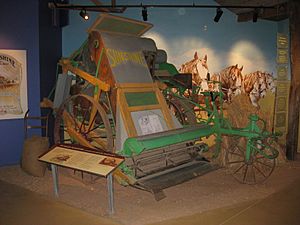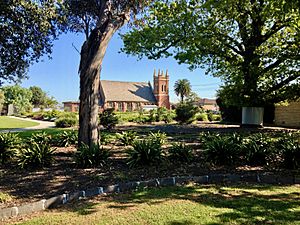Sunshine Harvester Works facts for kids
The Sunshine Harvester Works was a big factory in Australia that made farm machines. It was started by a clever person named H. V. McKay. The factory was named after his famous invention, the Sunshine Harvester, which was a type of machine that helped farmers harvest crops.
Contents
History of the Sunshine Harvester Works
How it All Began
H. V. McKay first had a factory in Ballarat. In 1906, he moved his factory and many workers to a new place called Braybrook Junction. He had bought another factory there in 1904. McKay decided to call his new, bigger factory the Sunshine Harvester Works. The name "Sunshine" might have come from a suggestion by James Menzies, who painted the first model of the harvester.
The Sunshine Harvester was a very important invention. It was one of the first successful combine harvesters in Australia. These machines made farming much easier and faster. The factory grew very quickly and became the largest in the Southern Hemisphere! At its busiest time, nearly 3,000 people worked there. In 1907, the area around the factory was even renamed Sunshine in honor of the factory. People started calling the town the "Birmingham of Australia" because it was such a busy industrial place.
The Harvester Judgement
In 1907, there was a big disagreement at the Sunshine Harvester Works. It was between McKay and the workers' unions, who wanted better pay and working conditions. The case went to court, led by a judge named H. B. Higgins.
Judge Higgins listened to the workers and their families. He learned about their lives and how much it cost to support their families. In his decision, known as the Harvester Judgement, he said that McKay had to pay his workers enough money to live a "reasonable" life. This was a very important decision because it helped create the idea of a minimum wage, or "basic wage," for workers in Australia. This idea shaped how workers were paid for many years.
Growth and Changes
By the 1920s, the Sunshine Harvester Works was the biggest farm machine factory in the Southern Hemisphere. In 1924, they even created the world's first self-propelled harvester, which was a huge step forward!
H. V. McKay passed away in 1926. In 1930, a Canadian company called Massey Harris bought a large part of McKay's company. The two companies then merged their Australian operations to become H.V. McKay Massey Harris Pty Ltd. During World War II, the factory helped the war effort by sending many farm machines to England to help increase food production.
The Later Years
In the 1950s, the McKay family sold their remaining shares to Massey Ferguson. This new company was a combination of Massey Harris and a British tractor company. However, starting in the 1970s, many Australian factories faced tough times. The Sunshine Harvester Works slowly became smaller. In 1992, most of the factory was taken down to build a shopping center called the Sunshine Marketplace.
Even though most of the factory is gone, some parts are still protected because they are important to history. These include the old bulk store, the factory gates and clock tower, a pedestrian bridge, the factory gardens, and the main office building.
The Sunshine Estate: A Planned Community
McKay also created something special called the Sunshine Estate. This was a planned community for his workers, located in what is now part of Albion (which is part of greater Sunshine). It was an early example in Australia of a "Garden City."
What is a Garden City?
A Garden City is a special kind of planned town. It was an idea started by Ebenezer Howard in England in 1898. The goal was to combine the best parts of living in a city with the best parts of living in the countryside. Garden Cities were designed to be self-sufficient communities with lots of parks and open spaces.
McKay's Vision for Sunshine
H.V. McKay's plan for the Sunshine Estate had many ideas from the Garden City movement. He planned a new town on land that wasn't developed yet. He made sure there was important infrastructure, like electric lighting, parks, and places for recreation. He also set aside land for a school and a library. The houses for his employees were built on large plots of land, and there was a central garden for everyone to enjoy.
McKay even created the Sunshine Gardens, which are now called the H.V. McKay Memorial Gardens. These gardens were right next to the factory. They were a key part of his idea for a "garden suburb" where his workers could live happily. The gardens were a place for entertainment and outdoor fun for the whole community.
The way the streets and houses were laid out in the Sunshine Estate, especially on Leith Avenue, shows the influence of Garden City planning. It was a way to make life pleasant and secure for the workers. Sunshine is an important example of how these ideas came to Australia and helped shape how towns were planned in the early 1900s.



